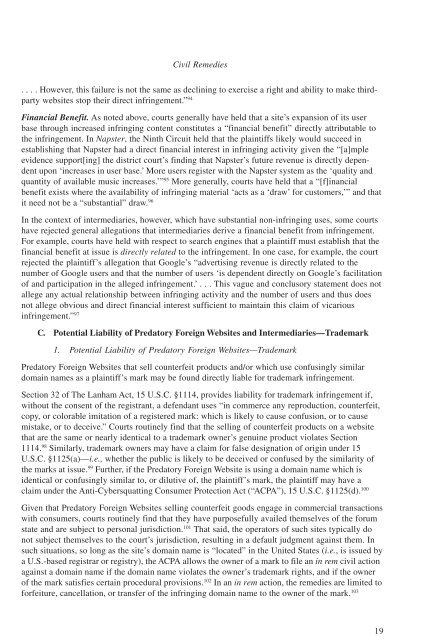1oz61wa
1oz61wa
1oz61wa
Create successful ePaper yourself
Turn your PDF publications into a flip-book with our unique Google optimized e-Paper software.
Civil Remedies<br />
. . . . However, this failure is not the same as declining to exercise a right and ability to make thirdparty<br />
websites stop their direct infringement.” 94<br />
Financial Benefit. As noted above, courts generally have held that a site’s expansion of its user<br />
base through increased infringing content constitutes a “financial benefit” directly attributable to<br />
the infringement. In Napster, the Ninth Circuit held that the plaintiffs likely would succeed in<br />
establishing that Napster had a direct financial interest in infringing activity given the “[a]mple<br />
evidence support[ing] the district court’s finding that Napster’s future revenue is directly dependent<br />
upon ‘increases in user base.’ More users register with the Napster system as the ‘quality and<br />
quantity of available music increases.’” 95 More generally, courts have held that a “[f]inancial<br />
benefit exists where the availability of infringing material ‘acts as a ‘draw’ for customers,’” and that<br />
it need not be a “substantial” draw. 96<br />
In the context of intermediaries, however, which have substantial non-infringing uses, some courts<br />
have rejected general allegations that intermediaries derive a financial benefit from infringement.<br />
For example, courts have held with respect to search engines that a plaintiff must establish that the<br />
financial benefit at issue is directly related to the infringement. In one case, for example, the court<br />
rejected the plaintiff’s allegation that Google’s “advertising revenue is directly related to the<br />
number of Google users and that the number of users ‘is dependent directly on Google’s facilitation<br />
of and participation in the alleged infringement.’ . . . This vague and conclusory statement does not<br />
allege any actual relationship between infringing activity and the number of users and thus does<br />
not allege obvious and direct financial interest sufficient to maintain this claim of vicarious<br />
infringement.” 97<br />
C. Potential Liability of Predatory Foreign Websites and Intermediaries—Trademark<br />
1. Potential Liability of Predatory Foreign Websites—Trademark<br />
Predatory Foreign Websites that sell counterfeit products and/or which use confusingly similar<br />
domain names as a plaintiff’s mark may be found directly liable for trademark infringement.<br />
Section 32 of The Lanham Act, 15 U.S.C. §1114, provides liability for trademark infringement if,<br />
without the consent of the registrant, a defendant uses “in commerce any reproduction, counterfeit,<br />
copy, or colorable imitation of a registered mark: which is likely to cause confusion, or to cause<br />
mistake, or to deceive.” Courts routinely find that the selling of counterfeit products on a website<br />
that are the same or nearly identical to a trademark owner’s genuine product violates Section<br />
1114. 98 Similarly, trademark owners may have a claim for false designation of origin under 15<br />
U.S.C. §1125(a)—i.e., whether the public is likely to be deceived or confused by the similarity of<br />
the marks at issue. 99 Further, if the Predatory Foreign Website is using a domain name which is<br />
identical or confusingly similar to, or dilutive of, the plaintiff’s mark, the plaintiff may have a<br />
claim under the Anti-Cybersquatting Consumer Protection Act (“ACPA”), 15 U.S.C. §1125(d). 100<br />
Given that Predatory Foreign Websites selling counterfeit goods engage in commercial transactions<br />
with consumers, courts routinely find that they have purposefully availed themselves of the forum<br />
state and are subject to personal jurisdiction. 101 That said, the operators of such sites typically do<br />
not subject themselves to the court’s jurisdiction, resulting in a default judgment against them. In<br />
such situations, so long as the site’s domain name is “located” in the United States (i.e., is issued by<br />
a U.S.-based registrar or registry), the ACPA allows the owner of a mark to file an in rem civil action<br />
against a domain name if the domain name violates the owner’s trademark rights, and if the owner<br />
of the mark satisfies certain procedural provisions. 102 In an in rem action, the remedies are limited to<br />
forfeiture, cancellation, or transfer of the infringing domain name to the owner of the mark. 103<br />
19


